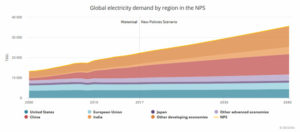
The World Energy Outlook 2018 report from the International Energy Agency (IEA) is a treasure trove of information. In great depth and clarity, it details past energy generation and consumption; makes forecasts under current conditions; and highlights key areas that – with more attention – can improve those forecasts. Amongst these many treasures, a tiny morsel of data resurfaces, as it has done every year since 2010. And every year, it becomes even starker and mysterious.

The first and most noticeable aspect of this data is just how stable advanced economy energy demand is. And in contrast, how developing economies are still working their way up to their relevant requirements. This is of course not particularly amazing: it stands to reason that growing economies would grow in energy demand.
This does, however, show a definite trend in energy demand – growing or not. Which makes one part of the graph remarkably noticeable…
What happened in 2009? Almost every country experienced a noticeable drop in energy demand, the likes of which haven’t been seen since 1982 – even to this day. Global recession is the cause. But why?
Recession is caused by – and causes – a contraction of economy: individuals and companies alike tighten the belt, slowing the flow of buying and selling. In energy terms, this hit the hardest in natural gas and oil, being fundamentally reliant on physical material. For the same reason, renewable sources like Solar and Wind were relatively immune. Curiously, coal generation seemed to be mostly unaffected too.
It wasn’t until 2010 that the trend was set back onto course, following all manner of solutions – including price reduction to get the flow moving again.
In my humble opinion, the most interesting part of this story is how resilient renewable energy sources are. The fact that they proved to be immune to recession seems like a simple point on the surface, but it holds huge implications. If 100% of generation was sourced from solar or wind in 2009, that dip may not have happened at all. In other words, when we reach 100% renewable electrical energy, energy demand may well be immune to economic instability – or at the very least remains consistent for short periods of economic upset. Since the causes and effects of recession are broadly the same, this means that not only will energy demand be resistant to recession, but may well act as an active preventative to it, driving economy through difficult times.

 (3 votes, average: 4.00 out of 5)
(3 votes, average: 4.00 out of 5)